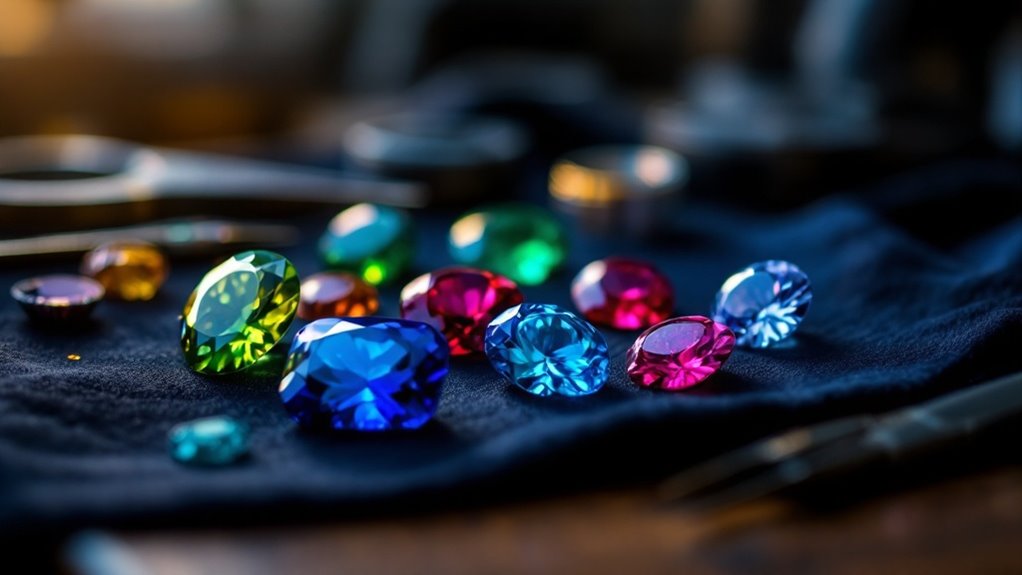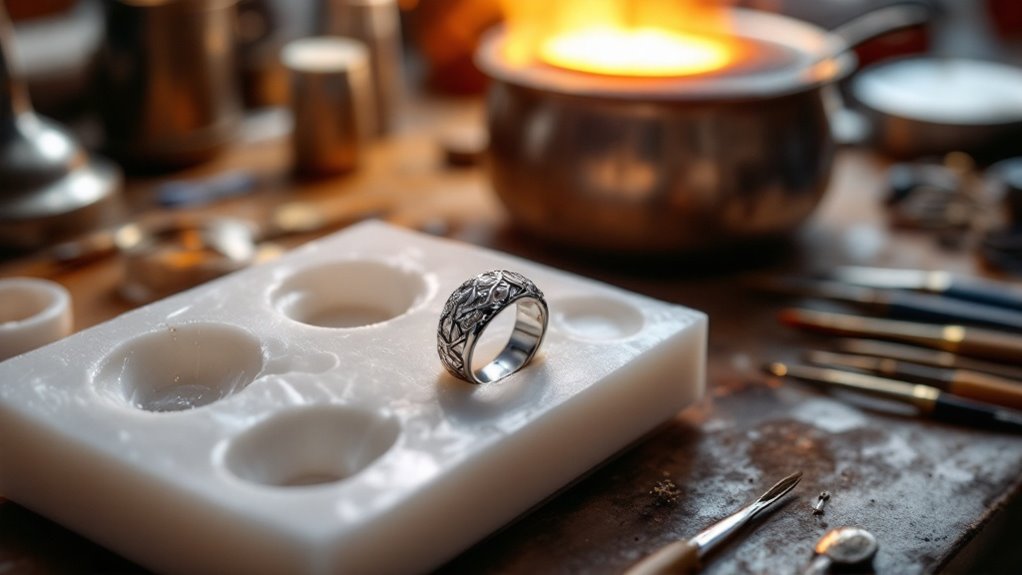When selecting gemstones, consider the Four Cs: color, cut, clarity, and carat, as they affect value and beauty. Evaluate gemstone durability for daily wear; opt for harder stones if active. Ethical sourcing guarantees responsible practices. Choose gems that align with personal style and occasions. The right setting enhances gemstone appeal and security. Disclose any treatments to guarantee informed decisions. These factors will guide you in discovering the ideal gemstone for your jewelry.
Understanding the Four Cs: Color, Cut, Clarity, Carat
When evaluating the quality and value of gemstones, understanding the Four Cs—Color, Cut, Clarity, and Carat—is essential. Color, defined by hue, tone, and saturation, plays a pivotal role in a gemstone’s appeal, with vibrant hues often commanding higher prices. The cut, which determines a gem’s shape and faceting, influences its brilliance and light reflection, enhancing its visual allure. Clarity assesses internal inclusions and external blemishes; clearer stones are generally more prized, though some inclusions can add unique character. Carat weight signifies size, yet a balance between size and the quality of color, cut, and clarity is significant for value.
Evaluating Gemstone Color and Its Impact on Value
Building upon the understanding of the Four Cs, gemstone color emerges as the most significant factor influencing a gem’s value. The components of gemstone color—hue, tone, and saturation—are essential in determining both appeal and worth. Vibrant, saturated hues generally command higher prices. Each gemstone variety has a preferred color range, with stones within this range considered more desirable. Personal preference also plays a role, as individual tastes can vary widely. Enhancements like heat treatment may alter color, often reducing value compared to untreated stones. Consequently, understanding color origin is vital for evaluating gemstone color and clarity.
The Importance of Cut in Enhancing Gemstone Beauty
The cut of a gemstone transforms its potential, dictating how light interacts to enhance its brilliance and appeal. Gemstone cuts and shapes are essential, as they determine the stone’s visual dynamics. A well-executed cut can amplify a gemstone’s color and sparkle, optimizing light reflection. Conversely, poor cuts lead to diminished allure, regardless of inherent color quality. Different cuts, including round, princess, and emerald, accentuate various characteristics; round cuts are synonymous with brilliance, while emerald cuts emphasize clarity. Evaluating cut quality involves analyzing proportions, symmetry, and polish, which collectively elevate the gemstone’s aesthetic and market value, showcasing expert craftsmanship.
Assessing Clarity and Its Influence on Light Interaction
Clarity plays an essential role in determining the value and desirability of gemstones, as fewer inclusions enhance both brilliance and visual appeal. Inclusions can interfere with light reflection, reducing sparkle and diminishing the overall aesthetic. Additionally, higher clarity not only increases rarity but also contributes to better durability, as fewer inclusions mean fewer potential weaknesses in the gemstone.
Inclusions Impacting Gem Value
While evaluating gemstones, determining clarity is essential as it greatly impacts both aesthetic appeal and market value. Clarity, a critical gemstone quality factor, refers to the presence of inclusions or blemishes within a stone. Fewer inclusions typically result in higher value, as they allow more light to pass through, enhancing brilliance and sparkle. Clarity grades, ranging from “Flawless” to “Included,” considerably affect market value. However, certain inclusions, such as silk in sapphires or rutile in quartz, can add unique beauty and increase desirability. Standardized grading systems like the GIA provide clear benchmarks for evaluating clarity and guiding buyers.
Light Reflection Factors
Light reflection plays a pivotal role in determining a gemstone’s visual appeal, heavily influenced by its clarity. Gemstones with fewer inclusions exhibit enhanced light transmission and brilliance. The clarity grading scale, ranging from Flawless to Included, greatly impacts light interaction, with superior clarity allowing better light reflection off facets. However, certain inclusions can add unique character without compromising clarity.
- Ideal clarity enhances visual brilliance, increasing gemstone value.
- Minimal inclusions guarantee effective light reflection, producing sparkle.
- Balanced inclusions can add character without detracting from light performance.
- Quality clarity contributes to both aesthetic appeal and gemstone durability.
Clarity and Gem Rarity
Although often overlooked, the clarity of a gemstone plays an essential role in determining its rarity and market value. Clarity, reflecting the presence of inclusions and blemishes, is graded from “Flawless” to “Included.” Fewer inclusions enhance light interaction, increasing brilliance and sparkle. For gemstone selection tips, understanding that some inclusions, like silk in sapphires, can add character is fundamental. Emeralds, often included, are more forgiving than diamonds.
| Clarity Grade | Description |
|---|---|
| Flawless | No inclusions under 10x |
| VVS | Very, very slight inclusions |
| VS | Very slight inclusions |
| SI | Slight inclusions |
| Included | Visible inclusions |
Considering Carat Weight in Gemstone Selection
When selecting gemstones for jewelry, carat weight is a significant factor that directly influences both the size and value of the stone. A gemstone carat weight of one carat equals 200 milligrams, with larger stones commanding higher prices due to rarity. It’s important to weigh carat weight against other factors like cut, color, and clarity to guarantee a piece’s overall beauty. Buyers should consider:
- Larger gemstones are visually striking but may lack in quality.
- Prices increase exponentially with carat weight.
- Balancing personal preference and budget is vital.
- Exceptional color can outweigh carat weight in colored gemstones.
Understanding these aspects aids in making informed choices.
Enhancements and Treatments: What You Need to Know
In the gemstone market, enhancements and treatments such as heat treatment, dyeing, and filling are frequently employed to improve a stone’s appearance and value. While treated gemstones are generally less rare, they can still be valuable if the quality of the enhancement is high, and jewelers must disclose these treatments to maintain transparency with buyers. Understanding these practices is essential, as natural, untreated gemstones often command higher prices due to their rarity and unaltered state.
Types of Enhancements
Gemstone enhancements are integral to the jewelry industry, serving to improve the appearance and marketability of stones. These enhancements include a variety of techniques:
- Heat Treatment: Enhances color and clarity, commonly applied to sapphires and rubies.
- Dyeing: Used to intensify or alter color in stones such as jade or agate.
- Filling: Involves injecting substances into fractures to improve clarity.
- Irradiation: Alters color, often used for diamonds and topaz.
Most colored gemstones are enhanced, making untreated gems rare and valuable. Buyers should rely on gemstone certification and reports from reputable labs to verify authenticity and understand any enhancements.
Disclosure Requirements
How essential is transparency in the gemstone market? It is vital, as disclosure requirements guarantee consumers are informed about enhancements or treatments, such as heat or dye applications, on gemstones. According to Federal Trade Commission guidelines, jewelers must disclose non-permanent treatments. This transparency allows buyers to make informed decisions, which is a key aspect of any gemstone buying guide. Additionally, lab-created gemstones must be clearly labeled, differentiating them from natural stones. Consumers can request written reports from reputable laboratories, which provide detailed information on a gemstone’s treatment status, thereby bolstering buyer confidence and assuring they understand their purchase.
Impact on Value
The allure of gemstones often lies in their vibrant colors and sparkling brilliance, attributes that can be greatly influenced by various enhancements and treatments. These modifications can considerably impact on value, as treated stones are usually less rare than untreated gemstones. Understanding these differences is essential for informed decisions. Most colored gemstones undergo:
- Heat treatment: Enhances color and clarity.
- Dyeing: Alters color, often lessening value.
- Filling: Improves appearance, but may reduce longevity.
- Untreated gemstones: Scarce and typically more valuable.
Jewelers must disclose treatments, as mandated by the FTC, ensuring transparency and authenticity for buyers.
Exploring Gemstone Durability for Daily Wear
When considering gemstone durability for daily wear, the Mohs scale offers a reliable measure of hardness, a key factor in determining a stone’s resistance to scratches. Diamonds, sapphires, and rubies, scoring 10 and 9 respectively, excel in durability. Softer stones like opals and pearls are more vulnerable. Toughness, or resistance to breaking, also matters; while emeralds are less durable due to inclusions, sapphires and garnets are ideal for everyday resilience. Lifestyle influences choice; active individuals benefit from durable gemstones. The table below outlines key considerations:
| Gemstone | Hardness | Recommended for Daily Wear |
|---|---|---|
| Diamond | 10 | Yes |
| Sapphire | 9 | Yes |
| Emerald | 7.5-8 | No |
| Opal | 5.5-6.5 | No |
Ethical Sourcing and Sustainable Practices
Why is ethical sourcing increasingly essential in the gemstone industry? Ethical gemstone sourcing guarantees that the industry does not contribute to conflict or human rights abuses. It emphasizes traceability and transparency, which are increasingly demanded by consumers. Sustainable practices in mining are equally crucial to minimize environmental impact and protect ecosystems. Certifications from reputable organizations further affirm that gemstones meet high ethical and sustainable standards.
Considerations for ethical gemstone sourcing include:
- Traceability: Knowing the journey from mine to market.
- Eco-friendly mining: Reducing ecological harm.
- Fair trade practices: Guaranteeing fair wages and safe conditions.
- Certifications: Assurance of ethical standards compliance.
Aligning Gemstone Choices With Personal Style and Intention
When selecting gemstones, individuals should consider their personal color preferences and the symbolic meanings associated with different stones, as these factors can evoke emotions and intentions such as love or protection. The choice should also align with one’s lifestyle and the occasions for which the jewelry will be worn, ensuring durability and style complement the wearer’s aesthetic. Additionally, reflecting on the metaphysical properties of gemstones can enhance the personal significance of the jewelry piece, creating a harmonious blend of style and intention.
Personal Color Preferences
Though individual tastes vary widely, personal color preferences greatly influence gemstone selection, as people often choose hues that resonate with their personality and emotional well-being. When choosing gemstones, individuals may consider the following:
- Emotional Resonance: Colors like blue or green may evoke calmness, while reds or oranges could inspire energy.
- Fashion Harmony: Selecting gemstones that complement one’s wardrobe can enhance personal style.
- Occasion Suitability: Certain colors may be more appropriate for specific events.
- Saturation and Tone: Vibrant colors often enhance a gemstone’s appeal and perceived value.
Understanding these elements helps align gemstone choices with personal aesthetic intentions.
Symbolic Gemstone Meanings
Selecting gemstones is a deeply personal journey, often guided by the symbolic meanings attributed to various stones. Amethyst, for instance, stands for clarity and peace, while garnet is linked to protection and strength, offering wearers a way to express personal values. Birthstones add another layer of significance, acting as unique talismans. Gemstone meanings extend to healing properties; rose quartz is famed for promoting love and compassion. Cultural interpretations also play a role—sapphires symbolize wisdom and royalty, whereas emeralds signify renewal. Incorporating stones that resonate with personal milestones or intentions enhances the emotional connection, making the jewelry truly meaningful.
Style and Occasion Fit
How does one choose the perfect gemstone to complement both personal style and occasion? This decision involves a nuanced understanding of style and occasion fit. When considering how to choose gemstones, one must align their selection with personal aesthetics and the event at hand.
- Personal Style: Select colors and cuts that echo individual preferences and enhance the wardrobe.
- Durability: Opt for robust stones like sapphires for everyday wear; reserve delicate ones like opals for special occasions.
- Symbolism: Consider gemstones’ meanings, such as wisdom-associated sapphires for graduations.
- Event Type: Choose simple designs for casual settings, bold pieces for formal events.
This thoughtful approach guarantees harmonious jewelry choices.
Choosing the Right Setting to Complement Your Gemstone
When choosing the right setting to complement a gemstone, one must consider how the metal’s color and finish can enhance or contrast the stone’s natural beauty. Warmer gemstone tones pair well with yellow or rose gold, while cooler tones suit white metals like platinum or silver. Buyers should assess the durability of both the gemstone and setting; harder stones like sapphires can endure intricate settings. Settings like prong or bezel affect light interaction and security. Additionally, understanding how gemstone shape influences setting compatibility is essential, especially when buying gemstones online, ensuring the piece is suitable for both occasion and style.
Conclusion
In selecting gemstones for jewelry, a thorough understanding of the Four Cs—Color, Cut, Clarity, and Carat—helps in making informed decisions. Evaluating these aspects alongside factors like durability, ethical sourcing, and personal style guarantees a balanced choice. Considering the gemstone’s setting further enhances its natural beauty, creating a piece that resonates with the wearer’s intentions and lifestyle. Ultimately, thoughtful consideration of these elements leads to a meaningful and cherished addition to any jewelry collection.





Leave a Reply